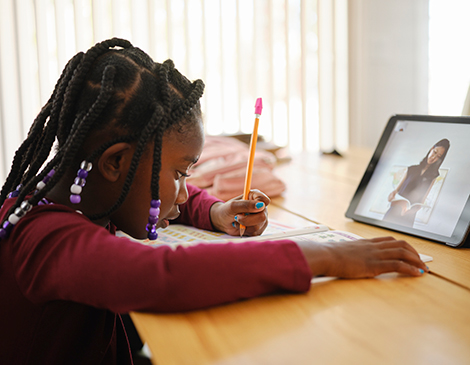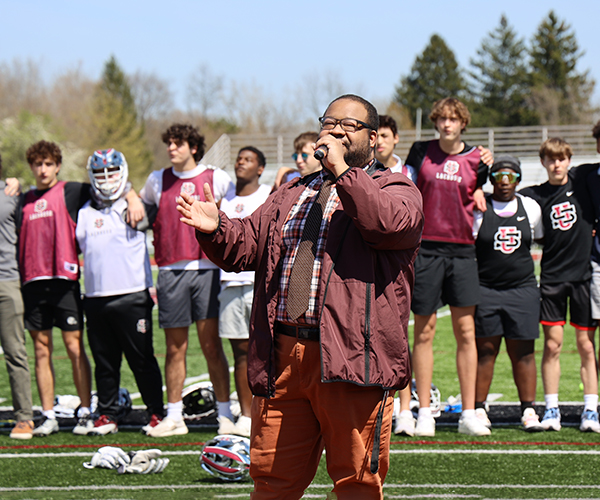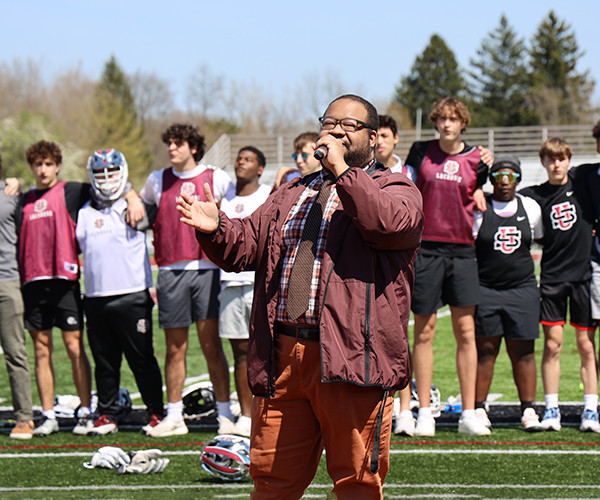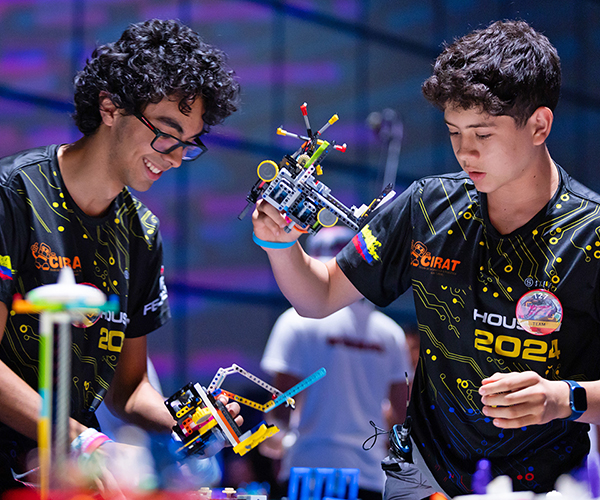“The core mission of our school is to provide an innovative, individualized educational experience,” says Josh McLaughlin, the director of whole child programming and design at Urban Community School. “We needed to design an engaging instructional program for all of our pre-K through eighth grade students.”
That innovation and ability to adapt has been crucial for area schools over the past year. With so much of education pivoting online, many students dealt with an overwhelming sense of isolation through the sudden shift to online learning. That said, the shift to digital learning also opened up a world of opportunity for area instructors.
“We had accessibility to speakers that might not have been able to get here in person,” says Sean Grosz, a science teacher at University School who also serves as the school’s associate director of admission and junior class dean. “They could hop on Zoom for a half-hour and talk to the class about careers.”
While some schools had some virtual options in place previously, the shift to digital reached an apex last March when schools shifted to online learning in response to the COVID-19 pandemic, immediately adopting digital learning tools such as Google Classroom, Seesaw and Zoom. “We had a two-week spring break, so we shifted into, ‘How are we going to make this work for kids even though school is online?’ ” Grosz says.
By the time summer 2020 rolled around, schools were designing return-to-building plans, many of which included hybrid learning. Some schools gave students an option to choose their learning plan while others made assignments.
After a year of online and hybrid learning, schools are entering a new phase where teachers are using lessons learned from digital teaching to inform the way their lesson plans are delivered.
“The gift of technology provides robust opportunities, and it’s an incredible option for those who need it,” says Rabbi Simcha Dessler, the educational director of Hebrew Academy of Cleveland.
While schools have begun to return to a fully in-person schedule, schools are starting this year knowing they have technology that offers flexibility, accessibility and an ability to pivot fast if the pandemic spikes again.
REIMAGINING THE SCHOOL DAY
Administrators worked to find ways to switch up the monotony of the virtual school day. Urban Community School broke up that monotony with Whole Child Wednesdays, an all-day virtual celebration featuring special lessons based around yoga, music, dance, cooking and exercise, among other topics. The programs were put together in tandem with partners like Scamper Theatre Kids, The Foundry, The Music Settlement and MetroHealth’s Pediatric Wellness Center.
“Partnerships with other agencies gave us a better chance to do more creative things as opposed to a 50-minute block once every five days where you can’t always get to the same level as you’d like,” says Urban Community School president Tom Gill.
For McLaughlin, communication was key to developing a successful hybrid model.
“Halfway through last school year, we asked families, students and other stakeholders, ‘How is this going for you? How satisfied are you?’ ” he says. “We gathered feedback and made some tangible adjustments to the program.”
One of those changes was to reduce the number of instructional blocks while another was including mandatory offline, project-based learning blocks to limit the amount of screen time. With a full-year of remote gathering under their belts, Urban Community School has begun making Whole Child Wednesdays in-person.
“All of our fifth-grade students on Wednesdays are gearing up to head out to the Near West Theatre to work with the experts there,” McLaughlin says. “Over the course of 26 weeks, they will learn and put on their own production.”
STRIKING A BALANCE
Across the board, online learning looks different this year, particularly because the Ohio Department of Education modified its requirements for what an online learning model looks like at Ohio’s public schools.
Schools now can operate an “online learning school” that is a separate school from in-person learning. That said, schools can address short-term student illnesses or quarantining on a temporary basis with the online school. Additionally, if COVID-19 issues cause a school to switch to online learning, schools can offer blended learning that is a combination of supervised instruction and online delivery.
Essentially, parents can choose to send their kids to school in person like before the pandemic, with safety measures in place; they can home-school, which has always been an option; or they can register for an online school provided by the district or institution, if available.
After being forced to move to online and hybrid learning for the last 18 months, schools are now better equipped to handle unique learning situations.
For Vady Caraballo, whose 12-year-old daughter, Briannah, is now in seventh grade at Urban Community School, it’s a system that works.
“My daughter has a lot of allergies and would miss school when she got sick, and now it’s not like she is missing because she can log in remotely,” says Caraballo. “I had even more contact with teachers, and they constantly reached out and let me know if my daughter was struggling. It seemed like they were even more available than during a typical school year.”
However, school-at-home was still a challenge for Briannah, who had a tough time staying engaged and interested when in front of the screen.
“I do know a lot of parents that said hybrid worked out wonderful, their kids did really well and enjoyed it, but for her, it was distracting,” says Caraballo
Along the lines of communication, one way Hebrew Academy successfully implemented its hybrid program was to set up a tech support system with pointers for parents.
“This minimized the distractions for students and enabled them to maintain the structure and routine as far as attendance and participation every day,” Dessler says.
While the Hebrew Academy returned back to in-person learning last fall, it still continued to offer College Credit Plus classes online.
“Our parents wanted [in-building learning when feasible], and our children needed it,” Dessler says. “And research supported it. The American Academy of Pediatrics and CDC acknowledged that children thrive with structure, routine and socialization, and that in-person learning is the most beneficial.”
Classes at University School are also in-person. There is no formal hybrid option — as is the case with most schools, given the Ohio Department of Education’s aforementioned modifications that give families a choice of choosing an online school.
“The thing we learned from this is we have the ability to do school online, whereas before if a kid was out sick for a week [they’d miss school]” Grosz says. “Now, we will have the ability to serve those kids.”
INCREASING ENGAGEMENT
Student engagement is the main success factor of hybrid and online learning programs. It also might be the greatest challenge schools face when implementing virtual education. Not all subjects are created equal: some are easier to teach online while others work better in person. As a way to combat those differences last year, Grosz assigned in-building students with virtual learners as partners in his science classes. Those in the class would use a document camera to show the lab to the partner at home, and the online student would be given tasks like data collection while the “live” student performed the physical tasks.
“It’s not a perfect world, but it worked,” Grosz says.
Hybrid learning also presented a learning curve to teachers, who, along with adapting their lesson plans to different learning environments, also had to get information technology training.
“We started nonstop professional development with our IT director, and we had Zoom workshops to learn about different online tools,” Grosz says.
For students participating in online learning, a viable internet connection along with having a computer with a camera are critical.
Last year, Hebrew Academy distributed more than 1,000 Chromebooks to facilitate distance learning while Urban Community School made sure its students had the tech equipment and hot spots at home, if required. University School provided routers to students who had glitchy connections.
To combat burnout, University School extended the length of its classes while also mixing up the learning format.
“We used to do 45-minute classes and we went to 85-minute lessons with no more than 15 to 20 minutes on a given activity,” Grosz says.
Age and grade also play into hybrid learning success, as students face varying obstacles depending on their age level.
At the high school level, Grosz says freshmen were more likely to struggle with keeping track of online assignments. Seniors, on the other hand, were apt at organizational skills but struggled with the social disappointments of their graduation year like having a modified prom or graduation.
At this time, hybrid learning where students are in and out of the building as part of the regular curriculum is not the mainstream option at independent and public school. That said, online learning is ramped up after a school year of implementing flexible education — and it’s now a ready platform that schools have practiced using.
“The interesting thing about responding to an emergency is, the first thing you do is recover and stabilize, and then you think about a fresh-start opportunity over the long haul,” McLaughlin says, “[Now we’re thinking about] how we can recover and use this to think about how we might reinvent the things we do here.”




